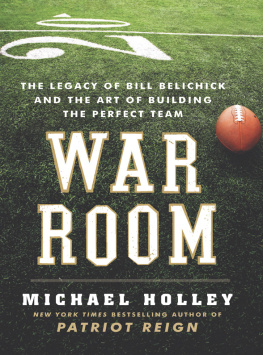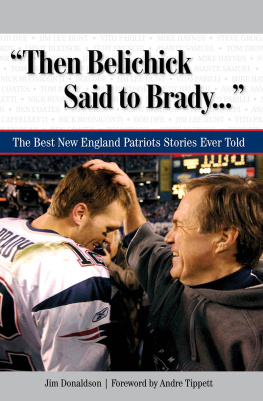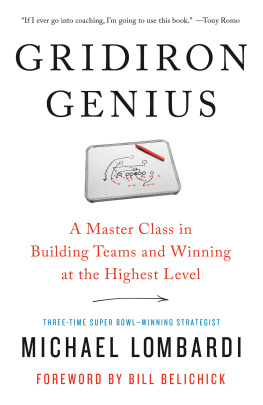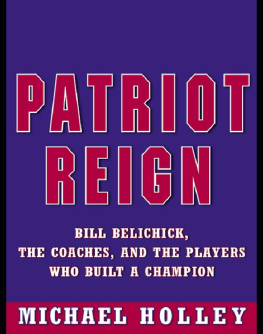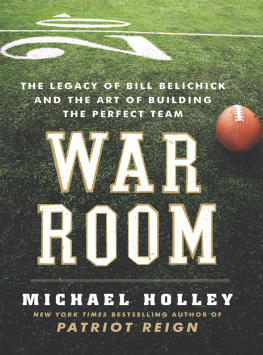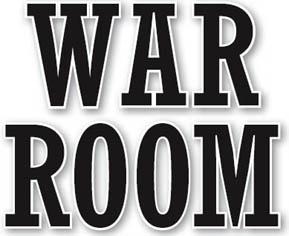CONTENTS


B ill Belichick, the dark-haired and youthful head coach of the Cleveland Browns, was full of ideas. Some, such as how he planned to limit the access of the media, were shamelessly lifted from the New York Giants, where he had spent a dozen years as an assistant coach. Others were original, simply a new coachs vision of what he wanted his team to be. It was the Big Idea, though, that was most ironic for Belichick in 1991.
The perception in northeast Ohio was that the thirty-nine-year-old coach, the NFLs youngest, was not a strong communicator. People used his press conferences as all the proof they needed. The first-year coach would seem bored as he sat or stood before the media giving shrugs, eye rolls, and terse answers to lengthy questions. But behind the scenes, Belichick was making clear communication his top Browns priority. In fact, it was how he planned to reconstruct one of the NFLs worst teams.
He quickly noticed that the Browns pro and college scouts were not speaking the same language. There was one grading scale for evaluating the pros and an entirely different one for analyzing collegians. Even worse, in his opinion, there was no organizational identity. After all the scouting, who were the Browns trying to be? It seemed to him that there wasnt a good systematic answer to the question, so that became one of his missions: Build one player-evaluation system, for pro and college players alike, that always provided an instant snapshot of who a player was and whether he was capable of helping the Cleveland Browns. When the system was perfected, the coach imagined, everyone in the organization would be able to glance at a couple of numbers and letters on a scouting report and know exactly what type of player was being discussed.
The easiest part of the plan was that the architect knew what he wanted. He told Mike Lombardi, his player personnel director, that he envisioned a big, strong, fast team that was capable of performing in any weather. He wanted a team that wouldnt be distracted by playing at least ten Rust Belt games each season: eight in Cleveland Stadium, which sat on the edge of the unpredictable shores of Lake Erie, and one game apiece in Cincinnati and Pittsburgh, both cold-weather cities with open-air stadiums that overlooked the Ohio River. He wanted a team that could answer the no-nonsense, gladiatorial style of the Steelers one week and then go to Houston, another divisional rival, a week later and not be confused by the unusual formations employed by the Oilers since they operated in a place, the Astrodome, where the temperature was always the same.
It was good that Belichick brought Lombardi specifics. But building and programming a unique system was going to require some after-hours work for both of them. While Belichick had been the defensive coordinator of two celebrated Super Bowlwinning defenses in New York, including one the previous season, he had no interest in copying the Giants scouting manual. He liked parts of it, but at times he thought it was too rigid and unnecessarily eliminated good players from draft consideration. He admired the grading system that Gil Brandt, the longtime Cowboys personnel man, had instituted in Dallas. For Belichick, Brandts scale made the Dallas system tangible, so even if the Browns were looking for different players from the Cowboys, they could use the Dallas scale as a sketch for where they were trying to go.
Lombardi was entering his fifth season working with the Browns when Belichick arrived, and he hadnt met him before. He soon learned that not every idea Belichick had was one that he wanted to see in place the next day. He was a thinker who liked to deliberately weigh information, listen to a variety of opinions, and then make decisions. Those personality traits alone would ensure that his overhaul of the Browns infrastructure was going to take time. It would also be an extended process because the system he wanted was, in the words of Lombardi, the equivalent of a race car that could be modified and become adaptable to any course you asked it to run.
There were also some generational dynamics that had to be taken into account with the restructuring. Belichick planned to rely on the smarts and experience of his veteran scouts, men who were evaluating players when he was still in junior high school. But there was also the reality that even with the best intentions, scouts in their midfifties and early sixties werent going to totally embrace a new way of doing business. That new way was fluid, and it might change two or three times in the next couple years before Belichick and Lombardi were comfortable with it. Scouts such as Dom Anile, Ron Marciniak, and Ernie Plank knew that their way worked, so it wasnt realistic to ask them to buy into something that wasnt even finished.
What Belichick needed was the wisdom of the scouts he had, as well as an influx of young, bright employees who would be raised in the Cleveland system. It was yet another idea he had when he took the job. He believed in developing scouts and coaches by hiring them for entry-level positions and then seeing if they could graduate from unofficial apprenticeships. The thought was that true football intellect and hunger could be displayed even while doing grunt work. And if the young employees were good at one thing, they would keep taking on responsibilities until they found their rightful place in the organization.
After the three-win team Belichick inherited won six games in 1991, the coach reached out to one of those gifted youth. Scott Pioli was a twenty-seven-year-old defensive line coach at Murray State, and Belichick offered him a $16,000-per-year job as a scouting assistant. The Cleveland job was a pay cut from Murray, where Pioli had once been so cash-strapped that he sold parts of his prized childhood baseball card collection so he could pay his less than $200 monthly rent. Pioli was a friend of a friend, and the report that Belichick got years earlier was that all the kid wanted was a career in football. He was an allNew England defensive tackle at Central Connecticut and he looked the part: He stood six feet tall, and even at ease, he appeared to have just finished three sets of bench presses.
Pioli thought he wanted to be a coach toward the end of his college playing days, and when he first met Belichick, he soaked up whatever he could from the brain of the Giants defense. When he told Belichick he was commuting 120 miles each day from his hometown of Washingtonville, New York, to watch the Giants in training camp, Belichick told him he was welcome to sleep on the spare couch in the dorm room that Belichick shared with Giants assistant Al Groh.
He had absolutely nothing to gain by that relationship, or by that offer, Pioli says. He offered me something that was truly no strings attached. I couldnt do anything for him. Nothing. Zero. Zilch. The defensive coordinator of the Giants offered some kid from Central Connecticut a place to stay so he didnt have to travel as much and could watch multiple days of practice and film? That told me something about the guy.

